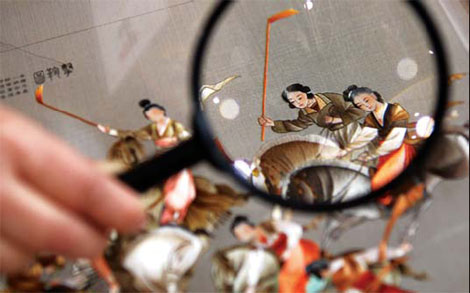
An embroidery by national intangible heritage inheritor Zhao Hongyu from Wuxi, Jiangsu province, is displayed at the exhibition.
About 2,000 items from 188 categories were showcased at the exhibition, which was the largest of its kind in China. It was sponsored by the Ministry of Culture and other ministries. The National Agriculture Exhibition Center event was different from previous intangible cultural history exhibitions in its focus on productive protection.
Minister of Culture Cai Wu said in his opening ceremony speech that China should adopt various methods to preserve its intangible cultural heritage.
Others are "salvage protection", used for endangered items, and "holistic protection", used to preserve areas in which many intangible cultural heritage forms are concentrated.
"Productive protection marks the relationship between preservation and economic development," Cai says.
The Ministry of Culture recently named 41 "bases for the productive protection of national intangible cultural heritage" and will issue the Direction on Enhancing Productive Protection of Intangible Cultural Heritage blueprint.
"My understanding of productive protection is the development of folk art through tradition inheritance," says Liu Lanfang, an embroiderer from Qingying, Gansu province, which is among the 41 bases.
Qingyang is an area famous for its embroidery, and Liu has collected many local specimens. She designs new products like purses and shoes using traditional patterns.
Liu's company has 24 regular employees, but most of the embroidery is done by thousands of women farmers, who work between harvests and plantings.
"People used to regard embroidery as solely for use in the home and generally worthless, but now the handicraft generates increasing economic value," she says.
A small, embroidered cloth tiger costs 350 yuan ($56), while bigger works often cost thousands of yuan. Liu's company has opened shops in several cities in China.
"I'm looking forward to the Ministry of Culture's adoption of policies favorable to intangible cultural heritage's productive protection, which will help our work," she says.
Many of the craftspeople at the exhibition run flourishing businesses.

Copyright ©1999-2011 Chinanews.com. All rights reserved.
Reproduction in whole or in part without permission is prohibited.